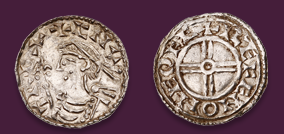
Auction: 10USA - NYC Currency and Stock & Bond Auction
Lot: 1062
Issued to Henry Phipps. All Unfolded. 1) United States Steel (NJ) 1901. #833. $100,000. 50 Year 5% Gold Bond, Series E. Olive green. Rail yard with smelter in distance. ABN. Unfolded. Purple stamp & 4 PO cancellations VF+. 2) #286. $5000. Series E. Olive green. Design as previous. Unfolded, save single corner. Purple stamp & 4 PO cancellations. EF. 3) #363. $5000. Series B. Dark green. Design as previous. Unfolded. Purple stamp & 4 PO cancellations. 4) Baltimore and Ohio RR #11470. 100. Preferred. Green. Top left roundel of Locomotive IBN. Soft corner fold. Blue stamp & 9 PO cancellations EF. [4] Henry Phipps was the son of emigrants from England. In 1845 the family moved to Allegheny City, Pennsylvania, across the river from Pittsburgh, where they lived next door to the Carnegie family. Carnegie´s mother, to help her hard pressed family make ends meet, worked in the elder Phipp´s shoemaking and saddlery shop. Henry Phipps was educated in the public schools and by his mother, and at thirteen worked in a jewelry store, also laboring for a time with a news and merchandise dealer. At seventeen Phipps obtained a position with Dilworth-Bidwell dealers in iron and spikes and the Pittsburgh agetnts for the DuPont Powder Works. He was first an office boy and clerk; later he advanced to bookkeeper, a position he held until 1861. Phipps´ boyhood friend, Andrew Carnegie, had secretly gotten involved in the Union iron Mills with Andrew and Anthony Kloman. Carnegie´s associate, Thomas Miller, advanced Phipps $800, with which he could become a partner with the Klomans. Phipps did the company´s books in the evening while continuing to work for Dilworth-Bidwell during the day. When the three partners began wrangling in 1863, Carnegie was brought in as a mediator. The agreement Carnegie negotiated reallocated interest so that Kloman held one-half, Phipps one-third, and Miller one-ninth. Phipps and Kloman later forced Miller out of the firm. Two years later Union Mills was merged with Carnegie´s Cyclops Iron Works. The new concern was controlled by Carnegie, with Phipps as his trusted lieutenant. From that point until 1901 Phipps would remain Carnegie´s most trusted "right hand man," and during the early years was thought of as somewhat of a financial wizard. It was said of him by some associates in Pittsburgh, "What we used to admire in young Phipps was the sskillful way in which he could keep a check in the air for two or three days. Although Phipps did not share Carnegie´s enthusiasm for steel making, he loyally went along with plans to erect the massive Edgar Thompson Works in 1872-73. Phipps and Tom Carnegie had observed a Bessemer converter in operation at Johnstown, Pennsylvania, and they helped in the conversion of Carnegie´s mills to steel maaking, with Phipps holding a significant interest in the new company. When Tom Carnegie died in 1881, Phipps was appointed his successor as chairman of the company. He was not, howeveer, an efffective organizer or executive. Therefore, Carnegie began searching for a replacement. In 1889 Henry Clay Frick was named to replace him. Phipps continued as a partner and trusted associate of Carnegie. Estimate US$ 250-500
Sold for
$250




